The Skylake Core i3 (51W) CPU Review: i3-6320, i3-6300 and i3-6100 Tested
by Ian Cutress on August 8, 2016 9:00 AM ESTLinux Performance
Built around several freely available benchmarks for Linux, Linux-Bench is a project spearheaded by Patrick at ServeTheHome to streamline about a dozen of these tests in a single neat package run via a set of three commands using an Ubuntu 11.04 LiveCD. These tests include fluid dynamics used by NASA, ray-tracing, OpenSSL, molecular modeling, and a scalable data structure server for web deployments. We run Linux-Bench and have chosen to report a select few of the tests that rely on CPU and DRAM speed.
All of our benchmark results can also be found in our benchmark engine, Bench.
C-Ray: link
C-Ray is a simple ray-tracing program that focuses almost exclusively on processor performance rather than DRAM access. The test in Linux-Bench renders a heavy complex scene offering a large scalable scenario.
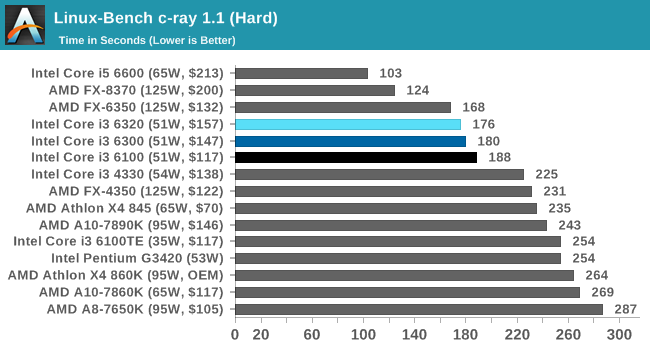
C-Ray is another bench that likes threads and high IPC cores, hence the i5-6600 sits out ahead followed by the FX-8350. At a lower price bracket, the FX-6350 with six threads wins out against the set of Core i3s, which follow their regular staircase pattern. The difference in frequency accounts for 4 seconds difference, and it seems the L3 cache difference accounts for another 4, or about 2%.
NAMD, Scalable Molecular Dynamics: link
Developed by the Theoretical and Computational Biophysics Group at the University of Illinois at Urbana-Champaign, NAMD is a set of parallel molecular dynamics codes for extreme parallelization up to and beyond 200,000 cores. The reference paper detailing NAMD has over 4000 citations, and our testing runs a small simulation where the calculation steps per unit time is the output vector.
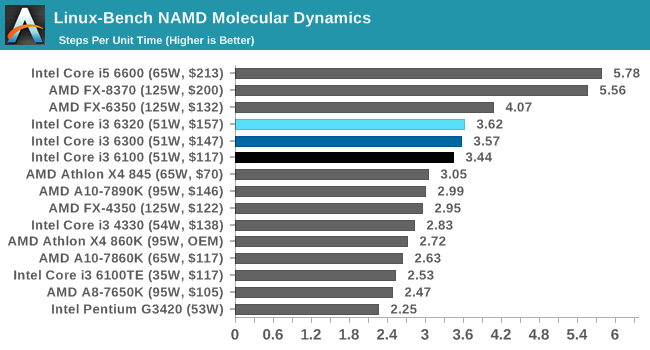
Similarly with NAMD, cores and IPC matter most. The Athlon X4 845 gets a good showing here for a $70 chip, beating the price/performance ratio of the Core i3s. Again, the AMD FX-6350 is ahead of the Core i3s, and the lopsided staircase means that the L3 cache difference accounts for another 2% loss in performance.
NPB, Fluid Dynamics: link
Aside from LINPACK, there are many other ways to benchmark supercomputers in terms of how effective they are for various types of mathematical processes. The NAS Parallel Benchmarks (NPB) are a set of small programs originally designed for NASA to test their supercomputers in terms of fluid dynamics simulations, useful for airflow reactions and design.
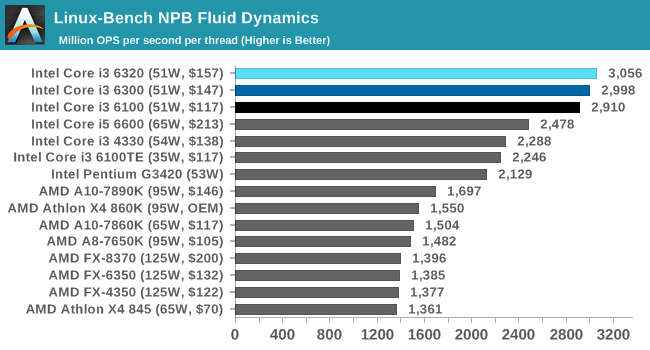
NPB clearly favors Intel CPUs, and the name of the game is IPC and frequency due to the i5 being behind the Core i3 parts. On the AMD side, the highest frequency part takes the lead and the thread count doesn't seem to matter much; neither does the microarchitecture, indicating that NPB is likely tuned for Intel.
Redis: link
Many of the online applications rely on key-value caches and data structure servers to operate. Redis is an open-source, scalable web technology with a strong developer base, but also relies heavily on memory bandwidth as well as CPU performance.
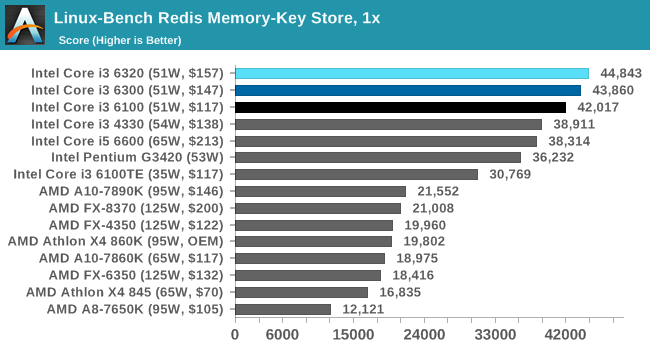

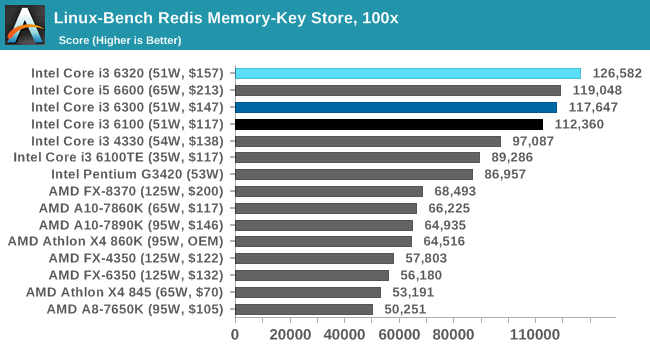
Redis is similar - high IPC and lots of fast cache are needed, and again it seems to be Intel tuned. The i5 sits below the set of Core i3s until the 100x loading comes along, where having physical cores and more cache seems to help. Despite saying more cache seems to help, the effect of the lower L3 cache on the i3-6100 seems to matter more in the 1x and 10x tests, but less in the 100x test, which is somewhat odd.










94 Comments
View All Comments
nightbringer57 - Monday, August 8, 2016 - link
Hard question.My guess would be that such models are core i3s with defective iGPUs, and overall lower binned, mostly destined to OEMs that could negotiate a lower price for almost identical performance (3% less frequency = no noticeable difference), in models with typically low-end dGPUs. While at the same time not price dumping the other i3s in the retail market (prices are always much more variable than the MSRP in the retail market and I would guess you could find them for slightly cheaper).
Once again, 3% frequency and 3W TDP don't make for much of a difference.
DanNeely - Monday, August 8, 2016 - link
Yeah it definitely looks like a binning dumpster - trying to salvage the last bit of value from chips with working HT but a damaged GPU that needed partially fused off. If the list price was marginally lower I wouldn't've thought anything of it, although I suppose Intel could be willing to offer better volume discounts behind the scenes.extide - Monday, August 8, 2016 - link
Yup, the 6098P has GT1 graphics, with only 12 EU's, vs GT2 and 24 EU's in all of the other i3's. I bet they are harvesting chips with bad EU's. As far as price goes, I am sure that whatever OEM is buying those is paying less than the prices on ARK. Intel is kinda famous for having tons of CPU's all the same price, but the OEM's buying them are going ot be paying totally different prices than whats on the price sheets/ARK. I would imagine the prices that they negotiate end up being lower for the lower models and higher for the higher models even if they are all listed the same on ARK.Ratman6161 - Monday, August 8, 2016 - link
I did a quick check and did not find any 6098's for sale on New Egg or Amazon. But I could see a position for them if the street price is less than a 6100. For anyone who is not going to use the integrated graphics anyway, saving a few more bucks on the CPU could be worthwhile. Has to be cheaper than a 6100 though because otherwise you would just get the 6100.Since I'm not finding any for sale, I'm also wondering if they will mainly be sold to OEM's and end up with people who wouldn't know the difference anyway in their low end Dell or HP desktop?
kuntakinte - Monday, August 8, 2016 - link
Nice selective test :-). In comparision with rather old i3-4330 (3,5GHz) Skylake shines.But maybe you can add to the charts fastest i3 Haswell (i3-4370, 3,8 GHz). It's exactly in the middle of the tested three cpu's. But then i supose that Skylake "advantage" will drop to mere 2-5%.
lefty2 - Monday, August 8, 2016 - link
Actually, I was surprised that the iGPU sees zero improvement since Haswell.ImSpartacus - Monday, August 8, 2016 - link
This is an awesome subject that I've fascinated by. Good to see a proper review.AndrewJacksonZA - Monday, August 8, 2016 - link
Interesting that you kept the WinRAR test and let the 7-Zip test go to the "Legacy" section. Why? Did you do a coin toss between the two? :-)stephenbrooks - Monday, August 8, 2016 - link
Right... a friend actually persuaded me to migrate *from* WinRAR *to* 7-Zip because it offered better compression.DanNeely - Monday, August 8, 2016 - link
As a file compression utility, 7zip is better than WinRar. Where Winrar stands out is as one of the very few real world applications whose performance is hugely dependent on memory speed; which makes it a great benchmark.